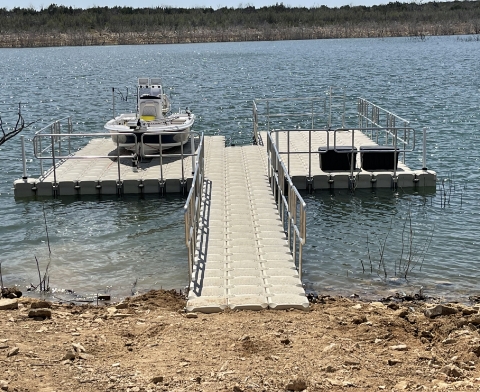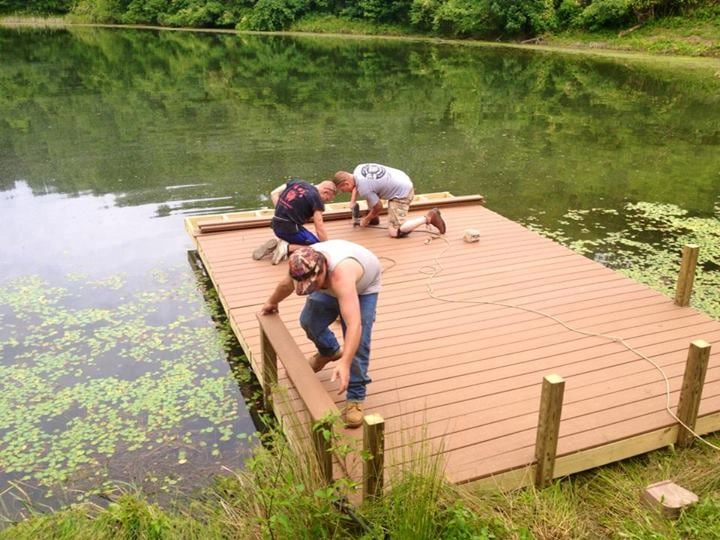Upgrade Your Waterfront With Sturdy Floating Docks
Updating your waterfront with durable floating docks can significantly improve both performance and aesthetic appeals, offering a flexible solution for different water activities. With a range of products available, consisting of low-maintenance choices and conventional wood, selecting the right dock can match your personal style and meet sensible requirements.
Advantages of Floating Docks
Floating docks offer a multitude of benefits that improve their appeal for numerous maritime applications. Unlike conventional fixed docks, floating docks surge and autumn with the trend, making sure consistent access for watercrafts and watercraft no matter of environmental problems.
Additionally, floating docks are less complicated to mount and relocate, giving versatility for momentary or seasonal usage. Their modular layout enables modification to fit particular demands, whether for private marinas, household watersides, or business applications.
Moreover, floating docks develop minimal disruption to the marine environment, protecting neighborhood environments and lowering the possibility of disintegration. They also supply boosted safety and stability for individuals, as their resilient nature offers a much more forgiving surface area than inflexible frameworks.
Furthermore, floating docks can assist in a varied series of activities, such as fishing, swimming, and leisure boating, making them a beneficial property for waterfront advancement. Their adaptability and functionality make floating docks a recommended choice for a selection of naval projects.
Choosing the Right Materials
Picking ideal products for floating docks is important to their durability, efficiency, and total effectiveness. When selecting materials, consider elements such as ecological direct exposure, upkeep needs, and structural stability. Typical products consist of timber, plastic, aluminum, and composite choices, each offering distinctive advantages and negative aspects.
Timber, while aesthetically pleasing, needs routine maintenance to avoid rot and degeneration. Pressure-treated timber can enhance resilience, yet it might still succumb to water damage in time. Plastic floats, usually made from high-density polyethylene, are immune to deterioration and call for marginal maintenance, making them an eye-catching selection for low-maintenance applications.
Light weight aluminum is one more sensible option, known for its toughness and lightweight properties. It is immune to rust and can withstand harsh weather, although it might be much more expensive than various other materials. Compound materials incorporate the finest characteristics of timber and plastic, providing a resilient and low-maintenance alternative that resembles the appearance of timber without the connected drawbacks.
Eventually, the choice of material need to line up with the intended use, ecological considerations, and spending plan constraints, making certain a resilient and useful floating dock that satisfies your details requirements.
Installment Process Introduction
The successful setup of a drifting dock depends on cautious preparation and execution, making sure that it operates efficiently in its desired environment. The very first step entails evaluating website problems, including water depth, coastline features, and prevailing climate patterns, which will inform the dock style and anchoring system.
Adhering to the site evaluation, the following stage is to prepare the floating dock components. This includes constructing the frame, protecting drifts, and affixing any required hardware. It is vital to ensure that all links are durable and water-resistant to stand up to aquatic conditions.
Once the dock is set up, the installment process additional reading begins with placing the dock in the water. This can include a crane or various other training equipment, especially for larger structures. Correct alignment is vital for performance and safety and security.

Maintenance Tips for Longevity
Normal upkeep is necessary for making certain the longevity and optimal performance of a floating dock. To accomplish this, start with regular evaluations at the very least twice a year, concentrating on view the stability of the dock's structure, including the flotation protection devices and linking equipment. Search for indicators of wear, corrosion, or damages, and address any kind of issues without delay to avoid more degeneration.
Cleaning is an additional vital aspect of maintenance. Remove particles, algae, and barnacles from the dock's surface to avoid slippery problems and maintain visual allure. Utilize a soft brush and a moderate cleaning agent to prevent damaging the dock's products.
In addition, make sure that the dock is properly anchored and protected to withstand seasonal adjustments in water degrees and climate condition. Inspect the anchoring system for security and make changes as essential.
Enhancing Your Exterior Visual
To develop an aesthetically enticing exterior room, incorporating a floating dock can considerably enhance the overall aesthetic of your waterfront building. Floating docks are not just practical yet can additionally offer as a striking focal factor that check it out enhances the all-natural environments - floating dock company. Offered in different materials and designs, these docks can be tailored to match your property's building design and landscape
The enhancement of ornamental elements, such as integrated lights or elegant railings, even more boosts the dock's aesthetic charm. Consider using all-natural timber finishes, which mix effortlessly with the atmosphere, or selecting modern-day products like aluminum or composite outdoor decking that supply a smooth, contemporary appearance.
Tactically placing planters or seating locations on or around the dock can produce inviting areas that encourage leisure and pleasure of waterfront sights. Additionally, including colors and appearances that balance with your landscape will develop a cohesive visual throughout your outdoor location.

Final Thought

Updating your waterside with sturdy floating docks can considerably enhance both capability and appearances, offering a functional service for numerous water activities. Unlike traditional fixed docks, floating docks rise and loss with the tide, guaranteeing constant ease of access for watercrafts and boat regardless of environmental problems.Picking appropriate products for floating docks is important to their long life, efficiency, and total effectiveness.When the dock is set up, the installment procedure commences with positioning the dock in the water.In summary, floating docks offer many benefits, consisting of flexibility to water degree adjustments and a variety of material options.